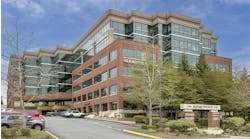LYND, MINN. — At Camden State Park's newly remodeled information/office building here, visitors will have the opportunity to learn about sustainable technologies and renewable energy in this working demonstration of a net-zero facility that incorporates a geothermal heat pump system and wind turbine.
The remodeling project, which also included an addition to the original building, was completed recently by LKPB Engineers Inc., St. Paul, Minn. With the addition, the finished building is approximately 30% larger than its original size — it's approximately 1,400-sq.ft.
According to John Killeen, vice president at LKPB Engineers Inc., who worked on the remodeling project, the energy costs should be lower through the use of sustainable design and system components.
“With Camden being located in a high wind area, the wind turbine option was a natural choice,” said Killeen. “Our studies showed that geothermal was also a good option because of the site's geographical location, soil type and the amount of land available. The design intent was to achieve a net-zero energy use building.”
The wind turbine is a 10 kW Bergey XLS, the first turbine specified by Minnesota's Department of Natural Resources for a park renovation project.
According to Jon Richter, who is responsible for outside sales at Energy Concepts, Hudson, Wis., the company that installed the wind turbine, this type of wind turbine was specified because it was capable of offsetting most the electricity to be used at the new facility. Plus, the location of the park is in a prime area for a wind turbine.
“Camden State Park is located in the southwestern corner of the state and is considered a very good wind site,” explained Richter. “The wind maps and the wind data collected in this area confirms that this site is close to some of the better wind in Minnesota. The wind speed averages about 13 mph on average yearly at the height of the tower, which is 120-ft. The Bergey 10 kW should produce on a yearly average about 12,000 kW of electricity.”
Jenniges Plumbing & Heating, Redwood Falls, Minn., installed the building's geothermal heat pump system. The system is a 4-ton, vertical closed-loop ground source heat pump by ClimateMaster.
According to John Jenniges Sr., president of Jenniges Plumbing & Heating, it took four days to drill boreholes for the loop, and the installation and hookup took about three days.
“This project is unique since it's the first one for the state of Minnesota,” said Jenniges. “They did add a wind turbine that powers the ground-source heat pump.”
Renewable energy
As the first major sustainable remodeling project for Minnesota's DNR, sustainable design and systems were a requirement since constructing a net-zero facility was a project objective.
“We determined at the beginning of the design process that renewable energy would be a component of this project in order to conserve energy and reduce agency carbon dioxide emissions,” said Peter K. Paulson, principal architect of the management resources department, DNR. “Our policy is to use well-tested ‘state-of-the-shelf’ technology to achieve our objectives, and the geothermal and wind systems implemented have shown a proven track record.”
To help better understand the potential for small wind turbines and geothermal systems, and explain and interpret sustainability goals and initiatives to the public, two energy monitoring systems are in use at the state park building.
“We are using two Web-enabled energy meters to measure turbine output and building energy usage,” said Rob Bergh, energy coordinator for Minnesota's DNR. “We have the ability to read both energy delivered to our building from the grid and the energy received by the grid from our building. Our goal is net-zero energy consumption over the course of a year.”
An interactive touch screen kiosk will soon be available at the park's Visitor Center. Visitors will be able to view current and historical data on weather, turbine energy production, building energy consumption and carbon emissions avoidance. The information at the interactive kiosk will also be available on Minnesota's DNR Web page for Camden State Park and other DNR parks with renewable energy installations.
“It is our hope that visitors to this park will take away a better understanding of smaller-scale renewable energy applications and the DNR's leadership role in this area,” said Paulson.

